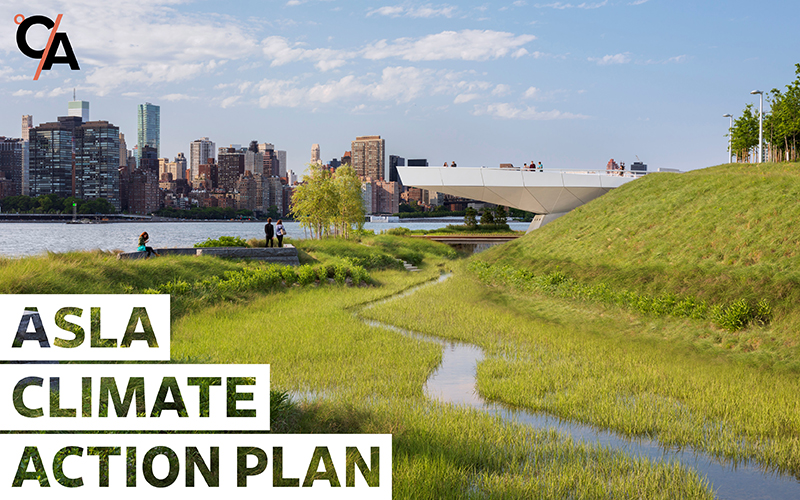News
Leading Landscape Architecture CEOs: We Will Be A Zero-Emission Profession By 2040, World Must Address Climate Change
 ASLA 2019 Professional General Design Honor Award. Hunter's Point South Waterfront Park Phase II: A New Urban Ecology. Long Island City, NY. SWA/BALSLEY and WEISS/MANFREDI with ARUP / copyright Vecerka/ESTO, courtesy SWA/BALSLEY and WEISS/MANFREDI
ASLA 2019 Professional General Design Honor Award. Hunter's Point South Waterfront Park Phase II: A New Urban Ecology. Long Island City, NY. SWA/BALSLEY and WEISS/MANFREDI with ARUP / copyright Vecerka/ESTO, courtesy SWA/BALSLEY and WEISS/MANFREDI
An open letter
Summer 2024 has once again laid bare the urgency of adapting our infrastructure for the extremes of a changing climate. As founders and CEOs of leading global landscape architecture firms, we see both immense opportunity and an immediate need for new policies, design tools, and solutions to help our communities thrive in a changing world.
This is a public commitment and call to action. Join us.
The Need
This summer has left communities across America reeling from extreme heat, fires, floods, and strong storms. These events are part of a worldwide pattern of rapidly changing climate forces resulting in increasing temperatures, violent weather events, rising sea levels, flooding, fire, and other damage to global ecosystems. And all too often, those with the fewest resources bear the brunt of the impacts. To remain viable and sustainable, our towns and cities, infrastructure, agriculture, and ecosystem management must adapt to a changing climate. And every year, the urgency grows—it’s time for big, bold, creative solutions.
The Opportunity
Because we work so closely with land and water, landscape architects are natural leaders in designing climate-resilient communities—from stormwater management to green infrastructure to sustainable transportation to biodiversity conservation. Every day, we design nature-based solutions to help build communities that are more resilient to extreme weather, more equitable for everyone, and more supportive of human health and wellness.
What does this look like? More urban trees cooling city centers and absorbing greenhouse gasses. Green infrastructure like parks and greenways to absorb and safely convey floodwaters. Landscapes that store more carbon than they emit while creating opportunities for human recreation and flourishing. This resiliency infrastructure is already hiding in plain sight all around you—but we need a lot more of it, and a lot faster.
We don’t do it alone, of course: Landscape architects lead and participate in multidisciplinary teams, working closely with policymakers, governments, non-profit organizations, private institutions, philanthropists, allied professionals, and the public. Landscape architects are trained to address the interrelated challenges of climate, equity, and wellness at the policy, program, and project level. Through communication, education, and project development, we help prepare people, communities, and the planet to thrive in changing conditions.
Landscape architects merge the understanding of natural processes, science, engineering, and human needs to designing environments that build on underlying ecological conditions. We specialize in designing environments that mitigate and adapt to the impact of climate change at the local, regional, and global scale, creating solutions to rescue, repair and restore global health and ecosystem resilience.
In short: Need a climate resilience response? Call a landscape architect.
Our Commitment
As founders and CEOs of the world’s largest and most influential landscape architecture firms, we represent design practices with global reach and projects of all types and scales.
In that capacity, we publicly commit to leading our respective practices toward a deeper understanding of the tools and solutions that landscape architects use to creatively adapt human communities, infrastructure, and environmental systems to the urgent and interrelated challenges of climate, biodiversity loss, equity, and wellness.
We publicly and expressly endorse, support, and commit to the goals articulated in the American Society of Landscape Architects (ASLA) Climate Action Plan, which sets specific and extraordinarily ambitious goals for the profession of landscape architecture to become a zero-emission profession by 2040, including in our business operations, designed landscapes, and the materials and products used in our work.
And, we will continue to strive for the ideals articulated in the Landscape Architecture Foundation’s 2016 New Landscape Declaration.
Our Call to Action
We call on our peers to join us in our commitments.
We call on our colleagues in allied disciplines to partner with us in designing and implementing solutions.
We call on leaders in government at every level to prioritize resilience, emissions reductions, and human wellbeing in their policymaking.
We call on our clients to be bold and curious as we design the future together.
We are propelled by the vision and determination of the rising generation to do more, faster on climate. The solutions are within reach; together, we must exert the will and the expertise to make a difference.
Signatories
Gerdo P. Aquino, FASLA, PLA
SWA
Thomas Balsley, FASLA, PLA
SWA/Balsley
Cheryl Barton, FASLA, PLA
Office of Cheryl Barton
Jim Burnett, FASLA, PLA
OJB
Andrea Cochran, FASLA,
ACLA
Shane Coen, FASLA, PLA
Coen + Partners
James Corner, FASLA, PLA
Field Operations
Michelle Delk, FASLA, PLA
Snøhetta
Michael Grove, FASLA, PLA
Sasaki
Jennifer Guthrie, FASLA, PLA
GGN
Joseph W. Healy
WRT Design
Gary Hilderbrand, FASLA, PLA
Reed-Hilderbrand
Douglas Hoerr, FASLA, PLA
Hoerr Schaudt
Mark Johnson, FASLA, PLA
Civitas, Inc.
Michael Johnson, ASLA, PLA
SmithGroup
Mary Margaret Jones, FASLA, PLA
Hargreaves Jones
Mia Lehrer, FASLA
Studio-MLA
Kate Orff, FASLA, PLA
SCAPE
Thomas Oslund, FASLA, PLA
O2 Design
Signe Nielsen, FASLA, PLA
MNLA
Lucinda Sanders, FASLA, PLA
Olin Studio
Martha Schwartz, FASLA, PLA
Martha Schwartz Partners
Douglas C. Smith, ASLA, PLA
EDSA
Ken Smith, FASLA, PLA
Ken Smith Workshop
Jay Swaintek, ASLA, PLA
PWP Landscape Architecture
Thaïsa Way, FASLA
Dumbarton Oaks